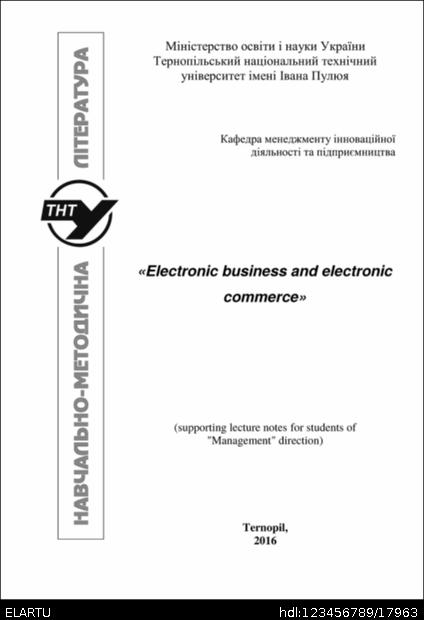Будь ласка, використовуйте цей ідентифікатор, щоб цитувати або посилатися на цей матеріал:
http://elartu.tntu.edu.ua/handle/123456789/17963

Повний запис метаданих
| Поле DC | Значення | Мова |
|---|---|---|
| dc.contributor.author | Федишин, Ірина Богданівна | - |
| dc.date.accessioned | 2016-09-25T13:14:35Z | - |
| dc.date.available | 2016-09-25T13:14:35Z | - |
| dc.date.issued | 2016-09-25T13:14:35Z | - |
| dc.identifier.uri | http://elartu.tntu.edu.ua/handle/123456789/17963 | - |
| dc.description | E-Business systems naturally have greater security risks than traditional business systems, therefore it is important for e-business systems to be fully protected against these risks. Customers, suppliers, employees, and numerous other people use any particular e-business system daily and expect their confidential information to stay secure. Hackers are one of the great threats to the security of e-businesses. Some common security concerns for e-Businesses include keeping business and customer information private and confidential, authenticity of data, and data integrity. Some of the methods of protecting e-business security and keeping information secure include physical security measures as well as data storage, data transmission, anti-virus software, firewalls, and encryption to list a few. | uk |
| dc.description | Розглянуто та рекомендовано до друку на засіданні кафедри інноваційного менеджменту та підприємництва, протокол No1 від 27 серпня 2015 року. Схвалено та рекомендовано до друку на засіданні методичної комісії факультету управління та бізнесу у виробництві Тернопільського національного технічного університету імені Івана Пулюя, протокол No6 від 26 лютого 2016 року. | - |
| dc.description.abstract | The purpose of thе document is to present the different underlying "technologies" (in reality, organizational modes based on information and communication technologies) and their associated acronyms. The term "e-Business" therefore refers to the integration, within the company, of tools based on information and communication technologies (generally referred to as business software) to improve their functioning in order to create value for the enterprise, its clients, and its partners. | uk |
| dc.description.tableofcontents | Topic 1. Basic concepts of electronic business and electronic commerce 1.1. Basic concepts and principles of e-business. 1.2. Origins and growth of e-commerce. Topic 2. Ecommerce as a part of electronic business 2.1. E-business infrastructure, e-environment and e-business strategy 2.2. Ways of e-business conducting. Online trading. Topic 3. Basis of global computer network internet functioning. 3.1. Basic principles of internet. 3.2. The most common services of Іnternet. 3.3. The concept and structure of Internet marketing. Topic 4. E-commerce systems in corporate sector 4.1. The basic processes of implementation of electronic commerce in the B2B sector. Virtual enterprise, internet incubator, mobile commerce. 4.2. The role of supply-chain management (SCM) and customer relationship management (CRM) in e-commerce. Topic 5. Information management for effective e-commerce building through intranet and extranet 5.1. Basic principles of Intranet functioning. 5.2. Extranet and its security issues. Topic 6. Electronic payment systems 6.1. Electronic payment systems. 6.2. Primary classification of payment systems. | - |
| dc.language.iso | en | uk |
| dc.title | Electronic business and electronic commerce (supporting lecture notes for students of dirеction "Management" of all forms of education) | uk |
| dc.type | Learning Object | uk |
| dc.rights.holder | © Федишин І.Б., 2016 | uk |
| dc.format.pages | 111 | - |
| dc.relation.referencesen | 1. Hoffman, D. L., and T. P. Novak. 1996. Marketing in hypermedia computer-mediated environments: conceptual foundations. Journal of Marketing 60 (July): 50-68. | uk |
| dc.relation.referencesen | 2. Business Software Alliance. 2001. E-commerce and Developing Markets: Technology, Trade and Opportunity. | uk |
| dc.relation.referencesen | 3. Bonnett, Kendra. 2000. An IBM Guide to Doing Business on the Internet. U.S.A.: McGraw-Hill. | uk |
| dc.relation.referencesen | 4. Cronin, Mary J. 2000. Unchained Value: The New Logic of Digital Business. U.S.A.: Harvard Business School Press. | uk |
| dc.relation.referencesen | 5. Mann, Catherine. Forthcoming. August 2000. “Global Electronic Commerce: Challenge and Opportunity for Government Policy.” In Company Secretary. Hong Kong Institute of Company Secretaries. | uk |
| dc.relation.referencesen | 6. “Maximizing Extranet Return” by Steven Bell, Mary Modahl and Gordon Lanpher of Forrester Research. July 1998. | uk |
| dc.relation.referencesen | 7. D. Chaffey. E-Business and E-Commerce Management, Strategy, Implementation and Practice, 4th or 5th edition | uk |
| dc.relation.referencesen | 8. Electronic payment systems : a user-centered perspective and interaction design / by Denis Abrazhevich. – Eindhoven : Technische Universiteit Eindhoven, 2004. | uk |
| dc.relation.referencesen | 9. Nielsen, J., Molich, R., Snyder, C., & Farrell, S. (2000). E-commerce user experience. Fremont, CA: Nielsen Norman Group. | uk |
| dc.relation.referencesen | 10. Ribbers, P. M. A. & Heck, E. v. (2004). Introducing electronic auction systems in the Dutch flower industry - a comparison of two initiatives. Wirtschaftsinformatik, 40 (3), 223-231. | uk |
| dc.relation.referencesen | 11. Schoenmakers, B. (1998). Basic security of the ecash payment system. In B.Preneel & V. Rijmen (Eds.), Computer Security and Industrial Cryptography: State of the Art and Evolution, (pp. 342-356). Springer-Verlag. | uk |
| dc.relation.referencesen | 12. Vulkan, N. (2003). The economics of e-commerce: a strategic guide to understanding and designing the online marketplace. Princeton, NJ: Princeton University Press. | uk |
| dc.relation.referencesen | 13. Wayner, P. (1997). Digital cash: commerce on the Net, (2nd ed.) London: AP Professional. | uk |
| dc.identifier.citationen | Electronic business and electronic commerce (supporting lecture notes for students of dirеction "Management" of all forms of education) / compiler : I.B. Fedyshyn. – Ternopil : TIPNTU, 2016. – 110 p. | uk |
| Розташовується у зібраннях: | Навчальна література кафедри управління інноваційною діяльністю та сферою послуг | |
Файли цього матеріалу:
| Файл | Опис | Розмір | Формат | |
|---|---|---|---|---|
| Lekciji_Electronic_business.doc | 587 kB | Microsoft Word | Переглянути/відкрити | |
| Lekciji_Electronic_business.djvu | 874,74 kB | DjVu | Переглянути/відкрити | |
| Lekciji_Electronic_business.pdf | 670,25 kB | Adobe PDF | Переглянути/відкрити | |
| Lekciji_Electronic_business__COVER.png | 115,39 kB | image/png | Переглянути/відкрити |
Усі матеріали в архіві електронних ресурсів захищені авторським правом, всі права збережені.
Інструменти адміністратора